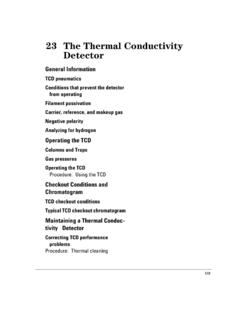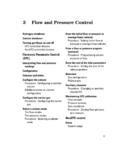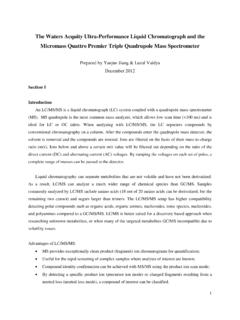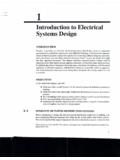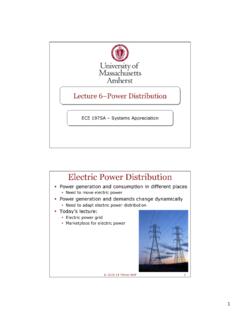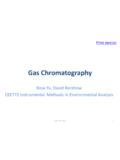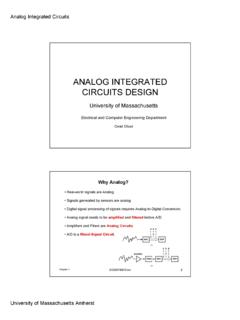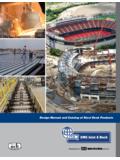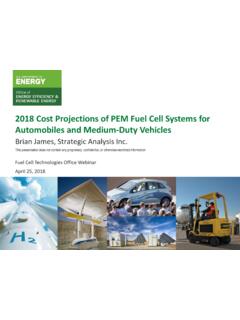Transcription of The Easy Guide to: Inductively Coupled Plasma- Mass ...
1 The Easy Guide to: Inductively Coupled Plasma- Mass Spectrometry (ICP-MS) By Arianne Bazilio & Jacob Weinrich December 2012 Contents Introduction .. 2 Sample Introduction .. 3 Torch .. 4 Interface .. 6 Mass Spectrometry .. 7 ICP-MS User Guide .. 9 Works Cited .. 11 2 Introduction Inductively Coupled Plasma- mass spectrometry (ICP-MS) is a powerful tool for analyzing trace metals in environmental samples. A large range of elements can be detected using an ICP-MS, which are summarized in Figure 1 below. Figure 1. Elements detectable by ICP-MS analysis (Perkin-Elmer) The ICP-MS system can quantitatively measure the colored elements in Figure 1, and give a measurement of the total amount of the specific element of interest.
2 The benefits of using plasma compared to other ionization methods, such as flame ionization, are that ionization occurs in a chemically inert environment, preventing oxide formation, and ionization is more complete. Also, the temperature profile of the torch is relatively uniform, reducing self-absorption effects. Linear calibration curves are observed over several orders of magnitude for ionization processes. The mechanisms in which ICP-MS analysis occur will be discussed in further detail. The process can be broken down into four stages; sample introduction, ICP torch, interface, and MS.
3 3 Sample Introduction The first step in ICP-MS is sample introduction. There are multiple ways in which a sample can be introduced, and the method of introduction depends on the physical characteristics of the sample. The various methods of sample entry are shown in Figure 2. While each method may be fundamentally different, they have the same goal: to sweep the sample of interest into the ICP torch in a gaseous or aerosol form for analysis. Figure 2. Potential sample entry pathways. (Skoog, Holler, and Crounch 2007) Typically, samples requiring ICP-MS analysis are in a liquid form.
4 However, the samples must be introduced to the torch in either a gaseous form or an aerosol form. Therefore, liquid samples require sample nebulization, seen in Figure 3. The liquid sample is pumped from a vial, via a peristaltic pump, into the nebulizer. Liquid droplets are formed on the tip of a needle, where they become nebulized due to argon gas flowing through a second needle perpendicular to the sample needle. A small amount of aerosol created is swept into the torch, but the majority of sample condenses on the walls of the nebulizer and is wasted to the drain. 4 Figure 3.
5 Schematic of liquid sample introduction to torch. (Skoog, Holler, and Crouch 2007) If a solid sample requires analysis, the most likely method of introduction would be via electrothermal vaporization. An electrothermal vaporizer uses electric current to rapidly vaporize a solid sample, which can then be swept into the ICP torch via argon gas flow. One fundamental aspect of ICP-MS analysis, which can be viewed as both a strength and weakness, is that elements are detected and quantified in total. In other words, no separation of compounds containing the element of interest occurs.
6 However, prior separation can occur via a chromatographic technique, such as gas chromatography, supercritical fluid chromatography, or liquid chromatography. Because gas and supercritical fluid chromatography separates samples in the gas phase, the eluents produced after column separation can be directly swept into the ICP-MS torch. However, liquid chromatography elutes, being in a liquid phase, require nebulization similar to that of standard liquid sample introduction. Torch The ICP torch consists of a copper induction coil wrapped around a concentric quartz structure, a schematic of which can be seen in Figure 4.
7 5 Figure 4. ICP torch schematic. (Skoog, Holler, and Crouch 2007) Argon gas is continuously flowing throughout the quartz torch, and a radio-frequency (RF) generator provides power to the RF coil at oscillating frequencies. Plasma (an electrical conducting gaseous mixture) generation occurs when the argon gas is seeded with a spark from a Tesla unit. The spark ionizes some of the argon, and the cations and electrons produced from that accelerate towards the RF coil. The cations and electrons collide with other argon molecules during this acceleration, creating high temperatures.
8 With ample argon supplied, the plasma will reach equilibrium and remain at a constant temperature of about 6,000 C for the duration of analysis. The aerosol produced via nebulization enters this high temperature plasma, where it is first dried to a solid, and then heated to a gas, referred to as atomization. These atoms will continue to travel through the plasma, absorbing energy until they release an electron, becoming ionized, referred to as ionization. These newly formed ions then travel out of the torch and come to the interface. 6 Interface Generally speaking, the interface can be described as the point at which sample from the ICP portion of the instrument is introduced to the mass spectrometry (MS) portion of the instrument.
9 The interface portion of the instrument serves to allow the ICP and MS portions to be Coupled . A general schematic of this interface can be seen in Figure 5. Figure 5. General schematic of interface. (Skoog, Holler, and Crouch 2007) The first component the sample matrix confronts after ionization in the ICP torch is the sampler cone. This is a water cooled cone with a small orifice, allowing for the hot plasma gas to enter a depressurizing chamber. In this chamber, rapid cooling, and thus rapid expansion, of the gas occurs. A fraction of this gas then passes through a skimmer cone, and into a chamber that is maintained at a vacuum of that of the MS.
10 This two-step pressure reduction allows the ionic gas to enter the MS at proper temperature and pressure. 7 Mass Spectrometry After passing through the sample and skimmer cones, the ion stream is focused into the quadrupole region by single ion lenses. Ions generated in plasma are nearly all positively charged and have a tendency to repel each other. The ions pass through a charged metallic cylinder which keeps the ion beam from diverging. The Elan DRC-e ICP-MS is equipped with a dynamic reaction cell (DRC). The DRC is located in the vacuum chamber between the lens and the quadruple.
